How to Crochet an Oval
Amigurumi & Crochet Design
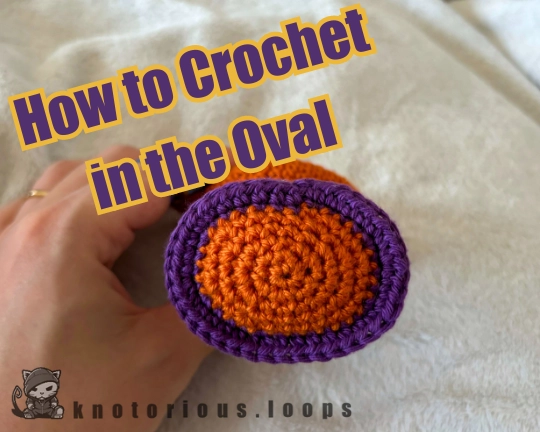
Show them (non-chicken) eggs some love!
Wazzuuuup Crochet Crew?
Another One! One more staple in my Amigurumi designs that I also consider wildly underutilized is crocheting an oval. Everybody knows how to crochet in the round and do circles and nice balls resulting from it. But truth of the matter is that crocheted ovals are simply just better suited for a lot of shapes in Amigurumi. So, let me show you how it’s done so you can go put a lot of them nice lil’ crochet ovals all over your Amigurumi designs!
There is 2 kinds of crochet ovals that I want to show you today.
DISCLAIMER: When speaking of “oval”, it’s actually an ellipsis shape but called “crocheting in the oval” anyhow, so I’m sticking to it throughout this page.
I crochet circles around everyone, why crochet an oval?
Now, you might think to yourself: “I can crochet nice circles and balls and make great Amigurumi from that”, and you’re not wrong there. But oval-based shapes can just make your crochet designs that tee-wee bit better and your life designing Amigurumi a lot easier. While, often you can achieve quite similar results with the right way of stuffing and shaping your Amigurumi, using a better crocheted shape from the get-go, like an oval, will help you get the same or better results in a more sustained manner.
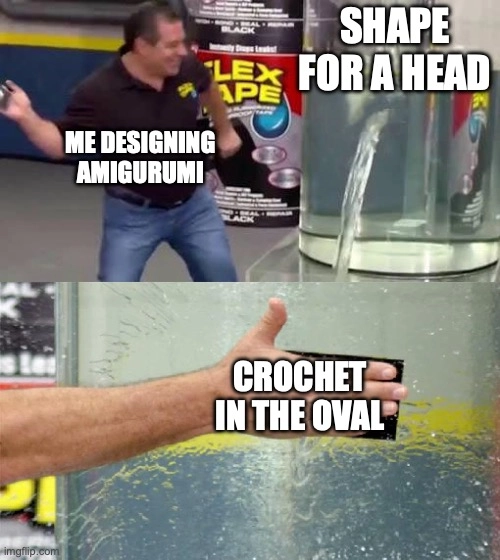
For example, going with a crochet oval aids you in maintaining aesthetic proportions, like a head does not need to have the same diameter all around. And so, adding round after round for example to get the appropriate width of a cat head, will just blow up your whole design, make it unnecessarily big and mess up the proportions. Also, there’s not a lot of perfect circles and balls out there in the wild, making oval-based shapes the much more natural shape and will help your designs to be much easier recognized as what it is supposed to be.
Other than that, there are certainly some shapes that simply ask for an oval shape, so it will come in handy at some point for sure.
What to use Oval for in your Amigurumi designs?
The simple answer: virtually everything, but going into more detail, crochet ovals as a base for Amigurumi come in especially handy when making feet or shoes, as they help to better capture the desired shape. Other than that torsos or bodies generally tend to look more authentic being worked upwards from an oval than a perfect circle. Many heads also benefit from a more oval shape than being a strictly perfect round ball. This is true for cat heads especially, giving them a more authentic touch, for sure.
Check out some examples of me using the crochet oval in my own Amigurumi designs below:
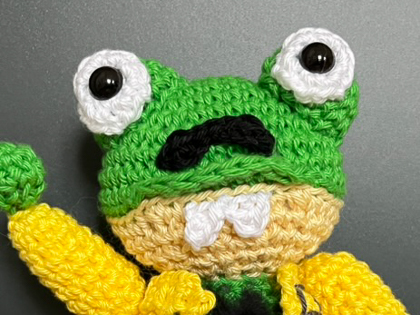
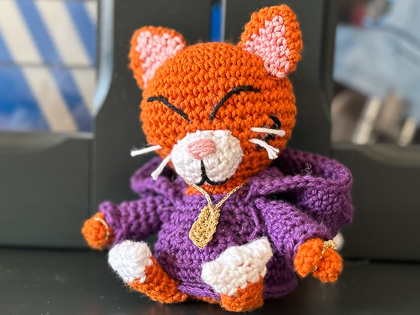
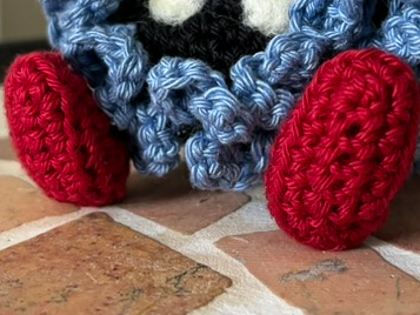
- The head in my Froggie Mercury pattern.
- The head, body and pendant shapes in my Kanye the Gangsta Cat pattern.
- Feet, always everywhere!
Step by Step instructions - Magic ring basis
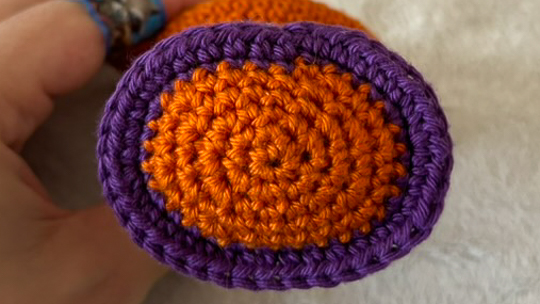
Start off with a Magic ring and put 6 single crochet stitches into it.
Make the second round the same way as you would do for a regular circle and bring your stitch count up to 12 by doing 6 increases.
Now, we start to deviate from business as usual. Instead of switching between a single crochet and an increase all the way around, start off the round with 3 single crochet stitches. This will end up being be the long side of your crochet oval.
Then, go on by doing 3 increases back to back. This will result in the curved tip of your crochet oval.
Repeat what you already did in this round for a second time. So, make another 3 single crochet stitches followed by 3 increases. This also marks the end of round 3. You should already notice an oval-like shape.
From here on after, the 3 single crochet stitches at the beginning and half point each will stay constant and you will proceed to add single crochet stitches between your increases the same way as you would do when crocheting a ball. So, for round 4 you will do the 3 single crochet stitches followed by 3 times alternating between a single crochet and an increase. The whole thing has to be repeated a second time to finish up this round of the crochet oval.
Increasing the number of single crochet stitches between each increase again brings us to 2 single crochet stitches and an increase. What I like to do for even numbers of single crochet stitches in between increases though, is split them up to put half of them before and the other half after the increase. So, instead of doing 3 times 2 single crochet stitches and an increase, that will be 3 times single crochet, increase and another single crochet. This is good for the oval shape, because this way increases end up a bit more on the curved sides, instead of all the way to the edge of that part and you will not have a visible seam of increases forming, as increases of each consecutive round will not be touching each other. But, I digress. So, this leaves us with 3 single crochet stitches followed by a single crochet, increase and another single crochet times 3 and then the whole thing repeated a second time. This not only was me brabbling a lot, but also brings us up to a stitch count of 30 and marks the end of round 4.
It’s probably easier to digest in pattern form. So, the written pattern of the crochet oval so far looks something like this:
| R1) | MR + 6sc | (6) |
| R2) | 6inc | (12) |
| R3) | [3sc, 3inc] x2 | (18) |
| R4) | [3sc, [sc, inc] x3] x2 | (24) |
| R5) | [3sc, [sc, inc, sc] x3] x2 | (30) |
| R6) | [3sc, [3sc, inc] x3] x2 | (36) |
| R7) | [3sc, [2sc, inc, 2sc] x3] x2 | (42) |
| … and so on. |
Step by Step instructions - Foundation chain basis
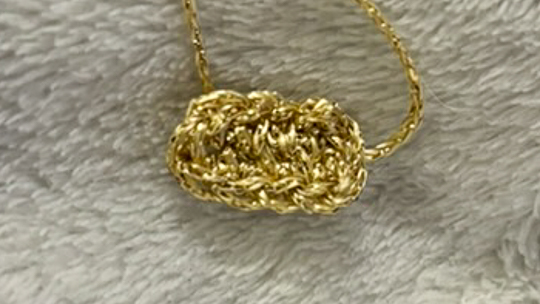
This technique is not that different to the previous one using the magic ring. But, by starting off with a foundation chain, we can increase the number of single crochet stitches on the 2 flat sides (which were 3 with the magic ring basis) and thereby create much different, namely longer and less rounded oval crochet shapes.
Start off with a foundation chain of the desired length. The more chains you make, the longer the flat sides of your crochet oval will be. For this example let’s chain 6 plus 1 for turning, so 7 chains in total.
For the first round, make 5 single crochet stitches so that you reach the end of the chain. Then put 3 single crochet stitches all into one chain and repeat the same thing on the other side of the chain. The basic oval shape should again already be visible.
Then, continue the same way as with the magic ring basis with the only difference of having 5 single crochet stitches as a constant on each flat side. This makes 5 single crochet stitches followed by 3 increases and that repeated a second time for round 2.
Then, you can proceed to add single crochet stitches in between the increases as you move on to further rounds, but I would not recommend to use this technique to add too many rounds. With every round, your flat piece will become more curved, so what I like to use this technique for most is feet/shoes by doing the first (max second) round and then proceed to form the rest of the foot/shoe by continuing in the back loop only. But, experiment with it and see what works for you.
Again, written as pattern this crochet oval versions looks something like this:
| ch7 | ||
| R1) | 5sc, 3sc in 1 chain, on the other side of the chain: 5sc, 3sc in 1 chain | (16) |
| R2) | [5sc, 3inc] x2 | (18) |
| … and so on. |
Congrats, you're now one step further on your journey to become an Amigurumi master designer! 💯
Mad props for checking out this tutorial of mine! 💜💛
Feel free to reach out to me via Instagram or E-Mail if you have any questions you wanna hit me with.
 knotoriousloops.com
knotoriousloops.com